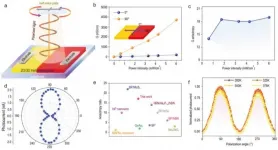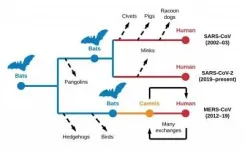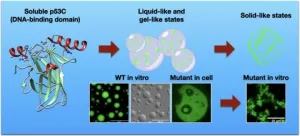Polarization-sensitive photodetection using 2D/3D perovskite heterostructure crystal
2021-05-04
(Press-News.org) Polarization-sensitive photodetectors, based on anisotropic semiconductors, have exhibited wide advantages in specialized applications, such as astronomy, remote sensing, and polarization-division multiplexing. For the active layer of polarization-sensitive photodetectors, recent researches focus on two-dimensional (2D) organic-inorganic hybrid perovskites, where inorganic slabs and organic spacers are alternatively arranged in parallel layered structures. Compared with inorganic 2D materials, importantly, the solution accessibility of hybrid perovskites makes it possible to obtain their large crystals at low cost, offering exciting opportunities to incorporate crystal out-of-plane anisotropy for polarization-sensitive photodetection. However, limited by the absorption anisotropy of the material structure, polarization sensitivity of such a device remains low. Thus, a new strategy to design 2D hybrid perovskites with large anisotropy for polarization-sensitive photodetection is urgently needed.
Heterostructures provide a clue to address this challenge. On the one hand, construction of heterostructures can improve the optical absorption and free-carrier densities of the composite. On the other hand, the built-in electric field at the heterojunction can spatially separate the photogenerated electron-hole pairs, significantly reducing the recombination rate and further enhancing the sensitivity for polarization-sensitive photodetectors. Therefore, constructing single-crystalline heterostructures of anisotropic 2D hybrid perovskites would realize devices with high polarization sensitivity.
In a new research article published in the Beijing-based National Science Review, scientists at the Fujian Institute of Research on the Structure of Matter, Chinese Academy of Sciences create a 2D/3D heterostructure crystal, combining the 2D hybrid perovskite with its 3D counterpart; and achieve polarization-sensitive photodetection with record-high performance. Different from the previous work, devices based on the heterostructure crystal deliberately leverage the anisotropy of 2D perovskite and the built-in electric field of heterostructure, permitting the first demonstration of a perovskite heterostructure-based polarization-sensitive photodetector that operates without the need for external energy supply. Notably, the polarization sensitivity of the device surpasses all of the reported perovskite-based devices; and can be competitive with conventional inorganic heterostructure-based photodetectors. Further studies disclose that the built-in electric field formed at the heterojunction can efficiently separate those photogenerated excitons, reducing their recombination rate and therefore enhancing the performance of the resulting polarization-sensitive photodetector.
"High polarization sensitivity is successfully achieved in self-driven polarization-sensitive photodetector based on a single-crystalline 2D/3D hybrid perovskite heterostructure which is grown via a delicate solution method," the author claims, "This innovative study broadens the choice of materials that can be used for high-performance polarization-sensitive photodetectors, and correspondingly, the design strategies."
INFORMATION:
This research received funding from the the National Natural Science Foundation of China, the Key Research Program of Frontier Sciences of the Chinese Academy of Sciences (CAS), the Natural Science Foundation of Fujian Province, the Strategic Priority Research Program of the CAS and the Youth Innovation Promotion of CAS.
See the article:
Xinyuan Zhang, Lina Li, Chengmin Ji, Xitao Liu, Qing Li, Kun Zhang, Yu Peng, Maochun Hong and Junhua Luo
Rational design of high-quality 2D/3D perovskite heterostructure crystals for record-performance polarization-sensitive photodetection
Natl Sci Rev DOI:10.1093/nsr/nwab044
https://doi.org/10.1093/nsr/nwab044
The National Science Review is the first comprehensive scholarly journal released in English in China that is aimed at linking the country's rapidly advancing community of scientists with the global frontiers of science and technology. The journal also aims to shine a worldwide spotlight on scientific research advances across China.
[Attachments] See images for this press release:

ELSE PRESS RELEASES FROM THIS DATE:
2021-05-04
During the next 10 years, an estimated half-million individuals in the U.S. with autism spectrum disorder (ASD) are expected to transition from adolescence to adulthood, according to the Centers for Disease Control and Prevention.
That means thousands of these young adults will likely fall into a widening and potentially devastating gap in a variety of services--because they're too old for high school, but may not qualify for Medicaid-funded services, social work researchers at Case Western Reserve University predict in a new study.
The team of researchers from the Jack, Joseph and Morton Mandel School of Applied Social Sciences interviewed 174 families from Northeast Ohio to examine the use of health, medical and social services for youth with autism--from 16 to 30 years old--and ...
2021-05-04
HOUSTON - (May 4, 2021) - Private equity investment in hospitals has grown substantially in the 21st century, and it accelerated in the years leading up the COVID-19 pandemic. Now a new study of short-term acute care hospitals acquired by private equity firms finds they not only have higher markups and profit margins, they're also slower to expand their staffs.
In a study published in Health Affairs, a multi-institutional team of investigators led by Dr. Anaeze C. Offodile II, a nonresident scholar in the Center for Health and Biosciences at Rice University's Baker Institute for Public Policy, the Gilbert Omenn Fellow at the National Academy of Medicine and an assistant professor of plastic and reconstructive surgery at The University of Texas MD Anderson Cancer Center, examined ...
2021-05-04
ORLANDO, Fla. (May 3, 2021) - Researchers have identified a gene expressed in children with acute myeloid leukemia (AML) that could serve as a new immunotherapy treatment target, according to a new study published today in Blood Advances, a journal of the American Society of Hematology. The study, co-authored by researchers with Nemours Children's Health System, outlines the process and potential path for new immunotherapy drugs that improve survival and reduce treatment-related toxicity in children with AML.
Leukemia is the most common cancer in children and teens, and AML accounts for nearly one-fourth of those cases. AML is a fast-growing cancer that typically starts in immature bone marrow cells.
"Using ...
2021-05-04
Coronavirus (CoVs) infection in animals and humans is not new. The earliest papers in the scientific literature of coronavirus infection date to 1966. However, prior to SARS-CoV, MERS-CoV, and SARS-CoV-2, very little attention had been paid to coronaviruses.
Suddenly, coronaviruses changed everything we know about personal and public health, and societal and economic well-being. The change led to rushed analyses to understand the origins of coronaviruses in humans. This rush has led to a thus far fruitless search for intermediate hosts (e.g., civet in SARS-CoV and pangolin in SARS-CoV-2) rather than focusing on the important work, which has always been surveillance of ...
2021-05-04
When was the last time you repainted your car? Redesigned your coffee mug collection? Gave your shoes a colorful facelift?
You likely answered: never, never, and never. You might consider these arduous tasks not worth the effort. But a new color-shifting "programmable matter" system could change that with a zap of light.
MIT researchers have developed a way to rapidly update imagery on object surfaces. The system, dubbed "ChromoUpdate" pairs an ultraviolet (UV) light projector with items coated in light-activated dye. The projected light alters the reflective properties of the dye, creating colorful new images in just a few minutes. The advance could accelerate product development, enabling product designers to churn through ...
2021-05-04
Since it was first introduced in 2016, transparent wood has been developed by researchers at KTH Royal Institute of Technology as an innovative structural material for building construction. It lets natural light through and can even store thermal energy.
The key to making wood into a transparent composite material is to strip out its lignin, the major light-absorbing component in wood. But the empty pores left behind by the absence of lignin need to be filled with something that restores the wood's strength and allows light to permeate.
In earlier versions of the composite, researchers at KTH's Wallenberg Wood Science Centre used fossil-based polymers. Now, the researchers have successfully tested an eco-friendly alternative: limonene acrylate, a monomer made ...
2021-05-04
Cancer has been recently shown to be affected by protein clusters, particularly by the aggregation of mutant variants of the tumor suppressor protein p53, which are present in more than half of malignant tumors. However, how the aggregates are formed is not yet fully understood. The understanding of this process is expected to provide new therapeutic tools able to prevent proteins to clump and cancer progression.
In Brazil, researchers at the Federal University of Rio de Janeiro have identified a key mechanism behind the mutant p53 aggregation process, linked to cancer pathology, opening new paths for the development of novels ...
2021-05-04
BAR HARBOR, MAINE — Our kidneys are charged with the extraordinary task of filtering about 53 gallons of fluid a day, a process that depends on podocytes, tiny, highly specialized cells in the cluster of blood vessels in the kidney where waste is filtered that are highly vulnerable to damage.
In research at the MDI Biological Laboratory in Bar Harbor, Maine, a team led by Iain Drummond, Ph.D., director of the Kathryn W. Davis Center for Regenerative Biology and Aging, has identified the signaling mechanisms underlying podocyte formation, or morphogenesis. The discovery opens the door to ...
2021-05-04
A team of University of Alberta researchers has discovered a way to use 3-D bioprinting technology to create custom-shaped cartilage for use in surgical procedures. The work aims to make it easier for surgeons to safely restore the features of skin cancer patients living with nasal cartilage defects after surgery.
The researchers used a specially designed hydrogel--a material similar to Jell-O--that could be mixed with cells harvested from a patient and then printed in a specific shape captured through 3-D imaging. Over a matter of weeks, the material is cultured in a lab to become functional cartilage.
"It takes a lifetime to make cartilage in an individual, while this method takes about four weeks. So you still expect ...
2021-05-04
Metallacages prepared via coordination-driven self-assembly have received extensive attention because of their three-dimensional layout and cavity-cored nature. The construction of light-emitting materials employing metallacages as a platform has also gained significant interest due to their good modularity in photophysical properties, which bring emerging applications in fields as diverse as sensing, biomedicine, and catalysis.
However, the luminescence efficiency of conventional luminophores significantly decreases in the aggregate state because they encounter unfavorable aggregation-caused quenching (ACQ). Therefore, it was quite a challenge to fabricate light-emitting metallacages with high luminescence efficiency in various physical states.
In 2001, Tang's group ...
LAST 30 PRESS RELEASES:
[Press-News.org] Polarization-sensitive photodetection using 2D/3D perovskite heterostructure crystal






